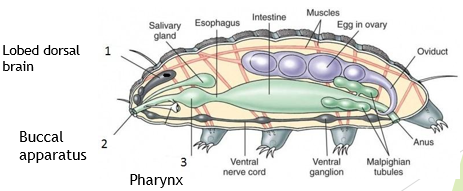
When i was in college i had the opportunity to work in a investigation on the RAD 51 GEN in Tardigrades. This gave me the opportunity to learn a lot about his species and i like to share a little information about them and where to find then.
Tardigrades they were first described by the German zoologist Goeze in 1773 who named them “water bears” because of their strong resemblance to these animals. The name tardigrade comes from the latin word Tardigradus which means slow moving. They are multicellular microscopic animals whose body length ranges from 0.1–1.2mm. More the 900 species of have been identified Although all individuals require water to be active, the environments in which tardigrades live are generally divided into marine and estuarine, freshwater, and terrestrial habitats in two main classes: Heterotardigrada and Eutardigrada
–Heterotardigrada: includes marine species with legs with 4–6 digits (toes) that have complex claws and/or sucking disks and terrestrial species with an armored cuticle and freshwater unarmored species with legs bearing up to 13 claws
–Eutardigrada: includes the unarmored terrestrial species, freshwater and marine with legs that terminate in claws without digits.
They can be found almost everywhere on earth from the top of the Himalaya to the bottom of the oceans. They are exceptional in their adaptations to the most extreme environments. They can survive in sub-zero temperatures, extreme heat, droughts and in the vacuum of space. They do this because they are capable of reversible suspension of their metabolism and entering into a state called cryptobiosis (latent life) or tun stage. Which is the collective name for a state of life used by some organisms to overcome periods of unfavorable environmental conditions. There are four main factors inducing cryptobiosis are: anhydrobiosis (desiccation), cryobiosis (freezing), osmobiosis (elevated solute concentrations), and anoxybiosis (low oxygen levels). This give the tardigrade their ability to survive. On this stage there been know to survive for more than a 100 years. But in their active stage only have a 28 days life span.
Though most tardigrades are herbivorous, some species can be carnivorous like in the case of Milnesium tardigradum. This species has been found to eat nematodes and rotifers, as part of their diet. We were lucky to film one eaten a nematode. Video below:
In the video you can see that the nematode is a lot bigger than the tardigrade but since they don't have a stomach they never stop eaten.

Collecting a tardigrade is a good experiment that you can try at home all you need is an knife, crystal glass and a 10x microscope (i added a video from YouTube in how to make a microscope with you phone).
You can find a tardigrade anywhere but the best pace to look is in dry lichen in the trees with the knife scrod the lichen of the tree into the crystal glass and add water; shake well for about 20 minute so the enter in the active stage.

Once is well shake remove all the remains floating on top. Tardigrade can't swim so they will go to the bottom. Them focus the microscope to the bottom of the glass and search for them. This photos were taken with our phones not the best quality but are originals.



On the last ones you can see one in tun stage and another pregnant leaving the eggs.
Hope you like the info.
Some reference:
http://www.sciencedirect.com/science/article/pii/S1096495901003001
http://www.artbytom.com/shop-for-art/The-Tardigrade-Queen.html
https://www.researchgate.net/publication/12044397_Cryptobiosis-A_peculiar_state_of_biological_organization
https://www.researchgate.net/publication/229917354_Ultraviolet_radiation_tolerance_in_hydrated_and_desiccated_eutardigrades
http://journals.plos.org/plosone/article?id=10.1371/journal.pone.0085091
http://journals.plos.org/plosone/article?id=10.1371/journal.pone.0064793
https://www.researchgate.net/publication/50394278_On_dormancy_strategies_in_tardigrades

Está impresionante
I love Tardigrades. They are just awesome little creatures that defy death XD And the photos taken with electron microscopy are so badass! https://goo.gl/mqPF5F
Hi. I am a volunteer bot for @resteembot that upvoted you.
Your post was chosen at random, as part of the advertisment campaign for @resteembot.
@resteembot is meant to help minnows get noticed by re-steeming their posts
To use the bot, one must follow it for at least 3 hours, and then make a transaction where the memo is the url of the post.
If you want to learn more - read the introduction post of @resteembot.
If you want help spread the word - read the advertisment program post.
Steem ON!
That's a very instructive post. Thanks for setting it up. If you allow me for a comment, it would be instructive to add a few references at the end of your post, on which readers could click to get more information (maybe the source of your information). I know you share already videos, but I was rather mentioning written information.
I am sure that if you do so, you will bet more support from the science community on steemit :)
I added some of the articles the were use has a reference. Thank You suggestion and support.
Thanks for your consideration! :)
Join us on #steemSTEM / Follow our curation trail on Streemian
Thank you for this very interesting article. It has been advertised on our chat channel (and upvoted).
The steemSTEM project is a community-supported project aiming to increase the quality and the visibility of STEM (STEM is the acronym for Science, Technology, Engineering and Mathematics) articles on Steemit.
Awesome, I love them, let me try to isolate them next time~
How many times magnification microscope should I be using?? Thank you~
with a is 10x is find also the best is to use a stereo microscope